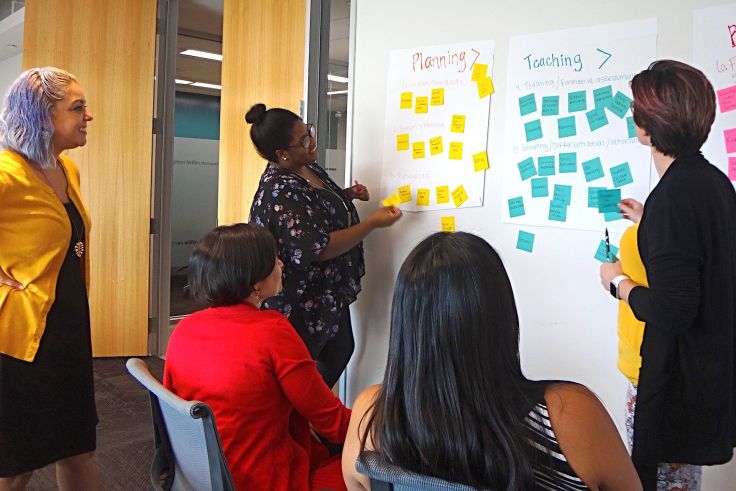Mila Kuznetsova, Director of User Research at Houghton Mifflin Harcourt
Houghton Mifflin Harcourt (or HMH for short) is a 4,000 person education and publishing company founded 180 years ago with their headquarters in Boston, Massachusetts. They are a leading provider of educational material for schools in the United States, publishing everything from K-12 core curriculum to Tolkien’s The Lord of the Rings.
Mila Kuznetsova is the Director of User Research at HMH based in New York City. She has a background in developmental psychology and neuroscience, a Master of Education from Harvard, and has previously worked at Scholastic and New York University.
What’s your organization’s mission?
Mila: At HMH, we want to create the fullest expression of what learning can be. We combine world-class instruction, data and insight, and professional support to deliver great outcomes for our students, teachers, and learning communities. HMH is a leading provider of K–12 core curriculum, supplemental and intervention solutions and professional learning services, and readers around the world recognize and love the HMH Books and Media catalogue. I’m constantly learning about new books we publish, from the Curious George series (he’s basically our mascot) to The Handmaid’s Tale.
My team is focused on the K-12 education space. We create content and learning experiences for a large share of students and teachers in the United States. With our magnitude of influence comes great social responsibility—to nurture, develop, and grow purposeful, empathetic, and determined citizens.

How does user research work across HMH?
Mila: We have a large group of people working under the Research umbrella at HMH. We are a learning company that focuses on educational outcomes. We have psychometricians, researchers, and data scientists all looking at the efficacy of the programs we put out into the market. On top of that, we also need to make sure our offerings are engaging for students and intuitive for teachers. That’s where my team comes in. We work across departments to investigate how our products are being used in the field and we make adjustments based on that important feedback before we launch. We are also engaged in continually improving our programs and platforms once they are out in the field. More and more of my time is being spent in schools watching our materials in action and making sure they are highly relevant and applicable to different types of classroom settings.
While we can’t gamify every single math lesson, we can certainly find a happy medium where we incorporate games when students are losing steam or struggling with a concept in order to help them reengage.
The User Research team is a relatively new practice within HMH, and this is reflective of larger important shifts in the learning space. More and more schools are leveraging technology or a blended approach (combining traditional print curriculum and digital solutions), and our digital footprint is quickly expanding. We are also seeing higher expectations from our users. For example, many schools are now using Google Classroom and they expect the same ease of use from us. Students also expect engaging and interactive content. While we can’t gamify every single math lesson, we can certainly find a happy medium where we incorporate games when students are losing steam or struggling with a concept in order to help them reengage.
Could you describe a recent user research project?
Mila: I’m working on building a network of Learning Labs. I would classify this type of work as ethnographic research. The “Labs” are schools, camps, and other programs where we’ve developed a strong relationship with the teaching staff over time. I find that the novelty of a visitor (me) in a classroom wears off for students and instructors once you’ve been there more than a handful of times. Once you are part of the community, the people you’re observing tend to go about their day and interact with your products as they would without you there. It gives me a good sense of how they are experiencing the programs, and I sometimes do some technical troubleshooting on the spot as well.
This type of work is probably the most time consuming, but it has also allowed us to stumble upon some things that we didn’t account for in previous research. For example, teachers routinely hack the curriculum, customize their content, and incorporate elements that resonate best with their students. Every classroom you visit is totally different. The rooms are filled with artifacts that reveal how they celebrate achievements or outline the flow of the day. We want to make sure we honor and empower all the different types of teachers and create experiences that allow them to optimize the time they spend with their students. All of these activities and observations have a meaningful impact on program development.

What software does your organization use? What have you tried in the past? What’s been working well?
Mila: We have a fairly large employee base (nearly 4,000 people) in 20 cities (and home-based) and we often have lots of stakeholders participate in the planning process of our user research work. To support this model, we rely on video calls and virtual meetings for broader discussions and working sessions, and we use Slack for the more detailed work.
Dovetail has made a big difference in our knowledge sharing and access capabilities for user research. We had developed a treasure trove of research over the years, and we felt somewhat limited by more traditional file sharing platforms, which essentially allowed us to put the research in one place, but not to explore and digest the information in an intuitive, user-friendly way. To ensure we all benefit from our research, we needed the search, tagging, and organization features Dovetail offers.
We care deeply about our content being relevant and effective, so we’ve made an effort to be out in the field as much as possible to understand how our programs are being experienced in classrooms.
What challenges do you have with user research?
Mila: We face some unique challenges when it comes to user research based on the nature of the education space. Working directly with students is a big hurdle because there are fairly strict guidelines (and rightfully so) when it comes to student participation in our projects, especially when we want to work with them in-situ. We care deeply about our content being relevant and effective, so we’ve made an effort to be out in the field as much as possible to understand how our programs are being experienced in classrooms.
It is also very important to be mindful of educators’ time. Teachers work around the clock—once class is done, they spend hours planning lessons for the upcoming day or week or grading assignments. It is not uncommon for our team to meet with a teacher at the end of the school day for an interview only to have them go right back to planning after the meeting.

What’s changing about user research at your organization?
Mila: Our team reflects a new and growing practice at HMH. We’re very focused on a holistic and user-centric approach to our research. We view school communities as complex systems and we approach teachers, students and education leaders with empathy. We recently conducted a comprehensive teacher ethnography study to better understand educators’ motivations, philosophies, challenges and more, and this type of research helps us gain an even deeper understanding of our users and develop profound ongoing relationships with them. We want to understand every aspect of their experience.
One thing we try to do is avoid DRIP (Data Rich, Information Poor). We have a relentless focus on providing relevant and actionable next steps for our product, engineering, design, and content teams.
We’re also getting a better feel of our audience within HMH. I have a lot of hardworking and thoughtful colleagues who love hearing insights from the field so we’re expanding our reach within the company. We have a dedicated Slack channel where we post findings and have created short one-pager documents to share insights in a quick and concise manner. One thing we try to do is avoid DRIP (Data Rich, Information Poor). We have a relentless focus on providing relevant and actionable next steps for our product, engineering, design, and content teams.

Why do you do what you do?
Mila: To put it simply, I love what I get to do each day. I’ve been in the education space in different roles for my entire career. I worked at a university, in the department of education for a major city, and now in curriculum development and edtech. I care deeply about making our programs relevant and efficacious.
I love the pace of the work and the impact we have on learners, and I know colleagues throughout the company feel the exact same way.
Everyone in our organization has been very responsive to the insights our team brings back as a result of our field research. It’s also a sweet spot to be in because although I sometimes have to be the bearer of bad news, you can’t really argue with what our users are telling us
Any advice for new user researchers?
Mila: My advice would be to find a field you love and then figure out a way to break into it. I didn’t know much about user research when I graduated from college with a focus on developmental psychology and neuroscience.
One of my first jobs was working as a researcher at a university. I spent years in the classroom doing observations, interviews, and tests. At some point I became involved in modifying and developing the protocols for our research projects. It always surprises that there can be a divide between research and practice, and I met PhD students who preferred not to visit our research sites or do any of the tests with users. I couldn’t imagine not interacting with practitioners and students! I love being in the field and this experience made me realize that maybe the ivory tower wasn’t exactly for me.
After my university days, I spent time working on teacher professional development and curriculum implementation. These experiences allowed me to see many different angles of teaching and learning. I’ve always had a lot of empathy for teachers and students, but collectively my experiences have allowed me to understand how we can improve some of the processes they use each day and to think more strategically about our users’ needs.
I’m friendly and upbeat, but it’s still intimidating for a four-year-old to hang out with a grownup they don’t know very well.
Also, and I can’t stress this enough, know your audience! The university research projects I worked on were based in preschools and kindergarten classrooms. I’m friendly and upbeat, but it’s still intimidating for a four-year-old to hang out with a grownup they don’t know very well. Simple things can make a big difference and help you connect with your audience. For example, I got a pair of purple glitter Converse as a gift from a friend and decided to wear them on a site visit. They were a hit! The shoes were an amazing conversation starter and made the sessions seem less serious and more fun and engaging for the kids. I wore those shoes into the ground and eventually had to retire them.


